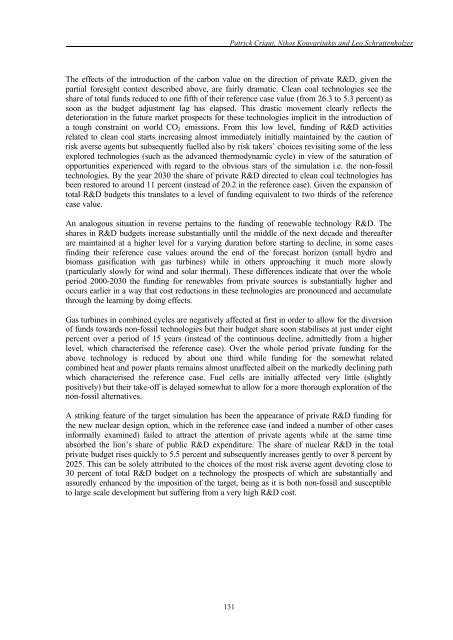sectoral economic costs and benefits of ghg mitigation - IPCC
sectoral economic costs and benefits of ghg mitigation - IPCC
sectoral economic costs and benefits of ghg mitigation - IPCC
You also want an ePaper? Increase the reach of your titles
YUMPU automatically turns print PDFs into web optimized ePapers that Google loves.
Patrick Criqui, Nikos Kouvaritakis <strong>and</strong> Leo Schrattenholzer<br />
The effects <strong>of</strong> the introduction <strong>of</strong> the carbon value on the direction <strong>of</strong> private R&D, given the<br />
partial foresight context described above, are fairly dramatic. Clean coal technologies see the<br />
share <strong>of</strong> total funds reduced to one fifth <strong>of</strong> their reference case value (from 26.3 to 5.3 percent) as<br />
soon as the budget adjustment lag has elapsed. This drastic movement clearly reflects the<br />
deterioration in the future market prospects for these technologies implicit in the introduction <strong>of</strong><br />
a tough constraint on world CO 2 emissions. From this low level, funding <strong>of</strong> R&D activities<br />
related to clean coal starts increasing almost immediately initially maintained by the caution <strong>of</strong><br />
risk averse agents but subsequently fuelled also by risk takers’ choices revisiting some <strong>of</strong> the less<br />
explored technologies (such as the advanced thermodynamic cycle) in view <strong>of</strong> the saturation <strong>of</strong><br />
opportunities experienced with regard to the obvious stars <strong>of</strong> the simulation i.e. the non-fossil<br />
technologies. By the year 2030 the share <strong>of</strong> private R&D directed to clean coal technologies has<br />
been restored to around 11 percent (instead <strong>of</strong> 20.2 in the reference case). Given the expansion <strong>of</strong><br />
total R&D budgets this translates to a level <strong>of</strong> funding equivalent to two thirds <strong>of</strong> the reference<br />
case value.<br />
An analogous situation in reverse pertains to the funding <strong>of</strong> renewable technology R&D. The<br />
shares in R&D budgets increase substantially until the middle <strong>of</strong> the next decade <strong>and</strong> thereafter<br />
are maintained at a higher level for a varying duration before starting to decline, in some cases<br />
finding their reference case values around the end <strong>of</strong> the forecast horizon (small hydro <strong>and</strong><br />
biomass gasification with gas turbines) while in others approaching it much more slowly<br />
(particularly slowly for wind <strong>and</strong> solar thermal). These differences indicate that over the whole<br />
period 2000-2030 the funding for renewables from private sources is substantially higher <strong>and</strong><br />
occurs earlier in a way that cost reductions in these technologies are pronounced <strong>and</strong> accumulate<br />
through the learning by doing effects.<br />
Gas turbines in combined cycles are negatively affected at first in order to allow for the diversion<br />
<strong>of</strong> funds towards non-fossil technologies but their budget share soon stabilises at just under eight<br />
percent over a period <strong>of</strong> 15 years (instead <strong>of</strong> the continuous decline, admittedly from a higher<br />
level, which characterised the reference case). Over the whole period private funding for the<br />
above technology is reduced by about one third while funding for the somewhat related<br />
combined heat <strong>and</strong> power plants remains almost unaffected albeit on the markedly declining path<br />
which characterised the reference case. Fuel cells are initially affected very little (slightly<br />
positively) but their take-<strong>of</strong>f is delayed somewhat to allow for a more thorough exploration <strong>of</strong> the<br />
non-fossil alternatives.<br />
A striking feature <strong>of</strong> the target simulation has been the appearance <strong>of</strong> private R&D funding for<br />
the new nuclear design option, which in the reference case (<strong>and</strong> indeed a number <strong>of</strong> other cases<br />
informally examined) failed to attract the attention <strong>of</strong> private agents while at the same time<br />
absorbed the lion’s share <strong>of</strong> public R&D expenditure. The share <strong>of</strong> nuclear R&D in the total<br />
private budget rises quickly to 5.5 percent <strong>and</strong> subsequently increases gently to over 8 percent by<br />
2025. This can be solely attributed to the choices <strong>of</strong> the most risk averse agent devoting close to<br />
30 percent <strong>of</strong> total R&D budget on a technology the prospects <strong>of</strong> which are substantially <strong>and</strong><br />
assuredly enhanced by the imposition <strong>of</strong> the target, being as it is both non-fossil <strong>and</strong> susceptible<br />
to large scale development but suffering from a very high R&D cost.<br />
131
















